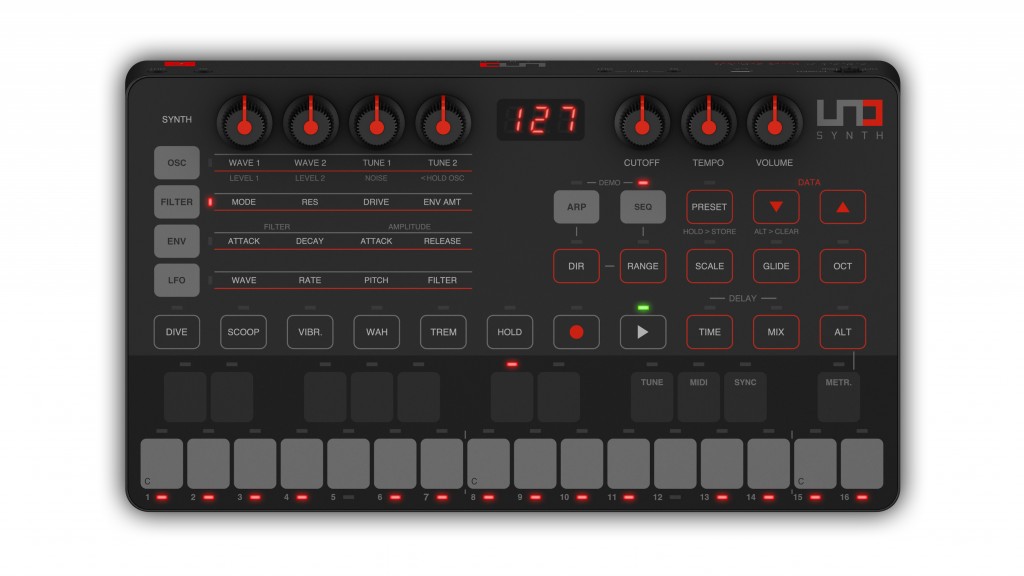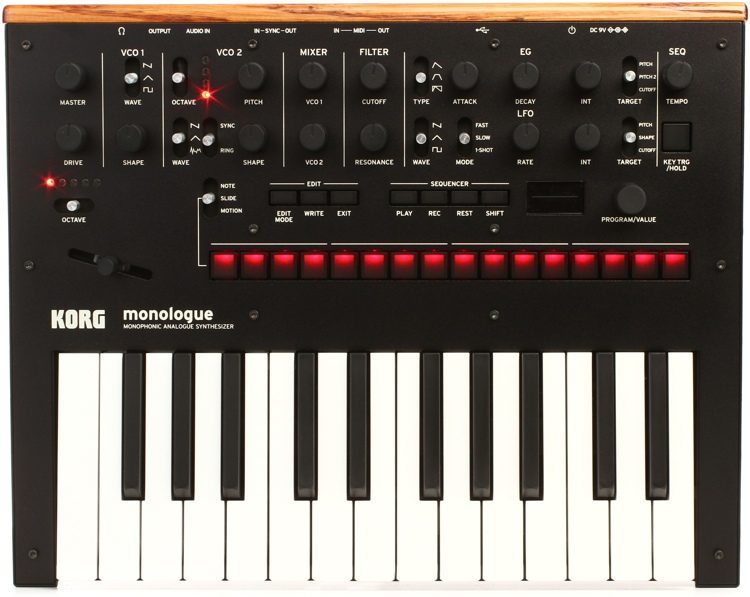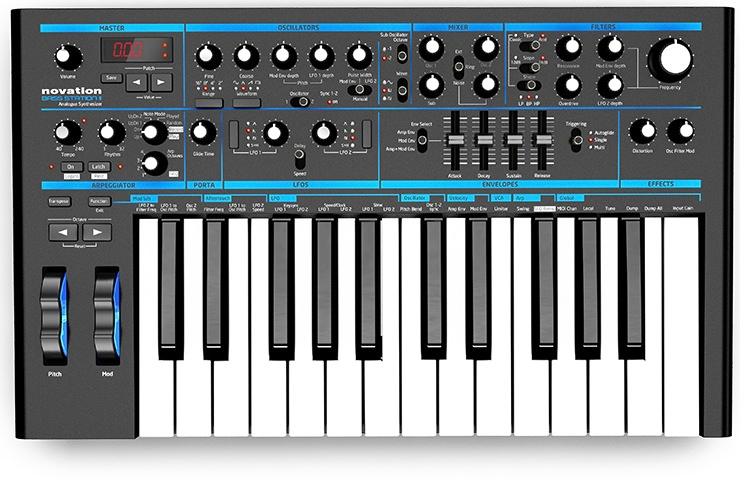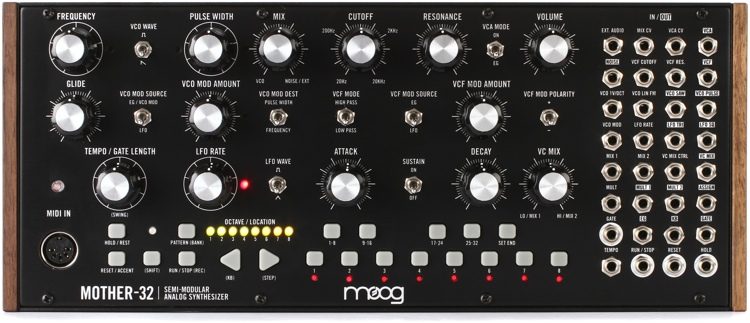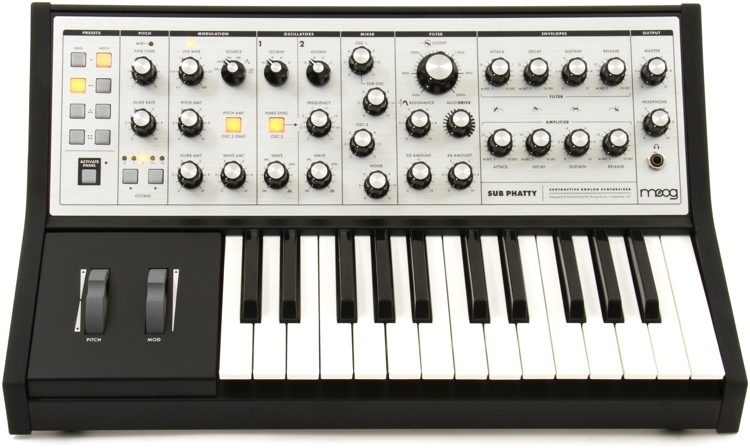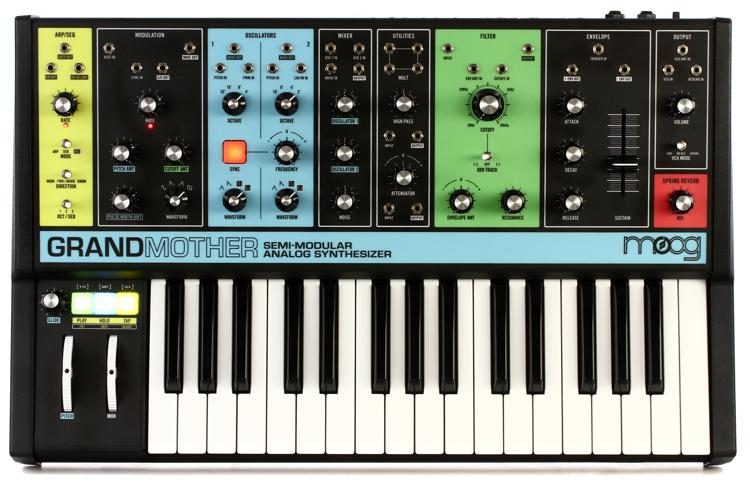7 of the Best Analog Synths Under $1,000
Due to how many analog synth options there are out there today, it can be intimidating to dive into the world of analog synthesis for the first time.
This is unfortunate because experimenting hands-on with a real analog synth is still one of the best ways to learn synthesis inside and out.
With the rise of plugins, analog synths have become something of a luxury item for music producers. Yes, software synths are relatively cheap and are capable of achieving a lot. However, the experience of creating sounds organically—detached from your computer and its constant visual feedback—is something that is still hard to emulate using software.
Fans are often drawn to analog synths because of the tactile experience they provide. Some die-hard synth enthusiasts will argue that “analog synths sound better than software synths,” but this just isn’t always the case. Analog modeling technology has advanced far enough that it’s almost impossible to tell the difference between digital processing and analog processing. (Take some of the top UAD plugins, for example.)
Most importantly, analog synths are just plain fun to use! Being able to sit down at an instrument and immediately start making music is a wonderful experience. You aren’t hindered by your DAW’s interface or the GUI of your software synth. Everything is laid out in front of you, and you’re able to easily twist knobs, slide faders, and patch modules together.
Moving over from plugin synths to analog synths is a bit of a shock at first. A plugin like Serum has tons of features and only costs $189. In the analog domain, a synth with similar specs would cost thousands of dollars. Sadly, the more features you pack into an analog synth, the more physical components you need to include under-the-hood.
If you’re ready to get started with analog synthesis, but want to keep the expense reasonable, this list contains seven of the best analog synths under $1,000. These synths aren’t just bottom-of-the-barrel toys either. Each unit has its own strengths and is a viable option for even the most professional studios.
IK Multimedia UNO Synth ($199)
If you’re looking for a portable, easily programmable, and affordable analog synthesizer, the UNO Synth is an excellent choice. It’s small enough to fit into a backpack, meaning you can take it almost anywhere with you. It has a set of 27 keypads that can also be used as a 16-step sequencer. The keypads default to a chromatic scale, but you can select from up to 13 different scale presets if you want to look like you can really shred even if your keyboard skills are lacking. This synth also includes a 10-mode, four-octave arpeggiator that allows for some beautiful arp sequences.
The two oscillators on board are continuously variable, and each one allows you to choose between a saw, triangle and pulse wave. There’s a 2-pole multimode resonant filter that will enable you to low pass, high pass, and bandpass your audio signal. MIDI CC or your software editor allows for full control over ADSR, and there’s also an LFO with saw, square, triangle, sine, random, and sample hold waveforms. These waveforms can be used to modulate pitch, filter settings, or your amp over time.
You can control the UNO Synth from the face of the unit using four encoders combined with button functions. There’s a simple numerical display with three digits (similar to a digital clock) that provides you with some essential visual feedback. Offering some of the convenience of the digital world, this synth allows you to recall presets, and it’s also self-tuning.
The Uno can be powered via a buss power connection (USB type micro-B), or with four AA batteries. In this price range, this unit offers a lot and can integrate easily into your digital setup as a controller and an additional sound source that can easily interface with your other hardware effects.
Korg Monologue ($299)
Shipping in five different colors, and capable of producing powerful monophonic basses and leads, theKorg Monologue is a strong competitor at this price point. This synth has 25 keys that range from E to E, along with micro-tuning capabilities, 12 user-saveable scales, and the ability to self-tune. There’s also a 16-step sequencer with per-step parameter lock.
Generating the Monologue’s waveforms are two VCOs. VCO 1 provides access to a saw, triangle, and square waveform, with waveshaping. VCO 2 allows access to a saw, triangle, and random waveform, with waveshaping, sync, and ring mod capabilities. A convenient and fun feature is the OLED oscilloscope screen that allows you to view how you’re affecting your waveform.
The Monologue also contains three envelope generator modes, and a dynamic LFO that provides incredibly slow to very fast modulation rates, and a 2-pole filter. It also has an analog drive circuit that can be used to add color to your sound, ranging from a slight punch to outright distortion. The Monologue ships with 80 factory presets, and you’re able to save 20 presets of your own too.
There’s a 1/4″ input, 1/4″ output, USB type B connection, MIDI in and out, and an 1/8″ sync in and out. This unit is powered by six AA batteries, or with an optional Korg Volca Power Supply that can be purchased separately.
Novation Bass Station II ($399)
Building upon the design of the original Bass Station, the Bass Station II allows you to create warm, fat,and dirty bass sounds. It comes equipped with a 25-key synth action aftertouch keyboard, as well as a pitch and mod wheels. There’s also a built-in arpeggiator and step sequencer with 32 different rhythmic patterns.
The Bass Station II has two main oscillators, plus a sub oscillator, that allows you to choose between square, sine, and pulse width waveforms. The two main oscillators can be hard-synced for really tight bass sounds. This lets you avoid phase cancelation between the waveforms produced by the oscillators, which can suck the life out of your bass patches. Controlling the sound is easy with the Bass Station II’s very intuitive oscillator section and two LFOs.
This synth has two filter designs that can provide drastically different sounds. One of these filters allows you to switch between low pass, band pass, and high pass, while the other is what is known as an “acid filter”—a special type of low pass filter with a 24/db slope that also allows you to achieve high levels of resonance. A neat feature here is what Novation calls “LFO slew,” which lets you distort the LFO waveforms. This provides a whole new level of modulation capabilities that you can’t get from your standard waveshapes alone.
You can get really creative with the real-time distortion and FM effects that the Bass Station II offers as well. Pulling together all the features of this synth are the 64 presets that the unit ships with. There are 64 user-assignable preset slots, allowing you to save your patches for later.
The Bass Station II lets you process line level inputs via a 1/4″ input. There’s also two 1/4″ outputs, a 1/4″ headphone output, USB type B connection, and a sustain pedal input. The device can be powered by either AC or USB bus power, making it a viable portable option for the road.
Moog Mother-32 ($599)
The Moog Mother-32 is the first semi-modular monophonic tabletop Eurorack synthesizer from Moog. It offers advanced signal routing options at what is still a fairly affordable price. The Mother has a 13-button one-octave keyboard, and a voltage-controlled 32-step sequencer with 64 sequence locations.
The Mother has one analog VCO capable of producing saw waves and pulse width waves. There’s also a white noise generator that allows you to create percussion sounds. Shaping the sounds produced by these sections is simple enough with the included envelope generator, which gives you control over attack, decay, and sustain. There’s also a 4-pole ladder filter with a 24dB/octave slope for lowpass and highpass, which lets you further shape the tone of your patch.
The 32-point modular patch bay is where all the fun happens, and there are 5 x 3.22mm patch cables included with the synth. There’s also a MIDI to CV converter and 5-pin MIDI input that lets you easily integrate this unit with the rest of your analog gear. Perhaps one of the coolest parts about this synth is that, since it’s a piece of Eurorack gear, you can install it into any of your Eurorack cases.
There are three 1/8″ inputs here for external audio in, mix 1 in and mix 2 in. There’s one 1/4″ TRS output for your headphones or audio out and five 1/8″ TS outputs which include a VCA out, VCF out, VCO saw out, VCO pulse out, and VC mic out.
Behringer DeepMind 12 ($699)
Moving up the feature spectrum is the Behringer DeepMind 12, a 49-key polyphonic synthesizer with 12 voices. Its keyboard is semi-weighted, velocity sensitive, and aftertouch-enabled. There’s a pitch wheel, mod wheel, two-octave buttons, and both a volume knob and portamento knob. Also included is a 32-step sequencer and arpeggiator.
With two oscillators per voice, a noise generator, an oscillator sync function, and a unison mode with detune options, you should be able to get some really lush sounds with this unit. There’s also a VCA envelope, VCF envelope, and an assignable mod envelope. Each voice has its own LFO which can provide some great textures. There are three ADSR generators per voice, and there’s also an 8-channel modulation matrix.
The DeepMind 12 has four simultaneous effects engines with TC Electronic, Midas, and Klark Teknik algorithms. These effects include a reverb, chorus, flanger, phaser, delay, multiband distortion, and more. There are two onboard analog modeled reverbs, including a Lexicon 480L and vintage EMT250 plate reverb.
With 1,024 patch memory locations, arranged into 8 banks of 128, you’ll be able to save all your favorite presets. These presets can be navigated using the encoder, navigation buttons, and sliders via the LCD display. The DeepMind can also be controlled over wifi using the DeepMind iOS app.
There are two 1/4″ TRS outputs for connecting this unit to your audio interface, a 1/4″ headphone output, and a USB type B connection. There are MIDI in/out/thru connections, and you can also control the DeepMind with MIDI via USB. There’s a 1/4″ sustain/trigger input, and a 1/4″ pedal expression/CV input. Powering the unit is a standard IEC power cable.
Moog Sub Phatty ($799)
When aggressive sound design is what you’re looking for, the Moog Sub Phatty is there to save the day.It’s going to provide you with dynamic and gritty basses. The Sub Phatty is a monophonic synth with 25 semi-weighted velocity-sensitive keys, 31 knobs, 13 switches, a pitch wheel, and a mod wheel. Two variable oscillators allow you to morph between triangle, saw, square, and pulse width waves. Also included is a square-wave sub oscillator in the mixer section, and a noise generator. With two envelopes giving you control over ADSR, it’s quite easy to shape your sounds over time.
The LFO in the modulation section ranges from 0.1Hz to 100Hz, so you can achieve quite a wide range of modulation effects. It allows you to choose between triangle, square, sawtooth, reverse sawtooth, and random waveforms. Additionally, you can set the LFO to “Filter EG” which bypasses the LFO and routes the filter’s envelope to the modulation destinations, which are determined by pitch amount, filter amount, and wave amount.
The Sub Phatty contains a ladder filter that offers a multi-drive knob that provides Minimoog style distortion when you drive it past 12 o’clock. There’s a resonance knob, EG amount knob that controls the depth of the envelope generator’s effect on the filter, and a KB amount knob that specifies how much the filter cut-off tracks the keyboard.
This unit has 16 presets that are available in four banks of four. Although there isn’t an extensive range of presets, you can still achieve a wide range of sounds with this unit. You’re not limited to creating bass patches and can just as easily develop leads.
There’s a 1/4″ audio input, 1/4″ audio output, USB type B connection, and MIDI in/out/USB. If you have other analog gear, you can control the Sub Phatty via its filter CV, pitch CV, volume CV, and keyboard gate connections. Powering the unit is a 110V AC-240V AC internal power supply.
Moog Grandmother ($899)
If you thought the Moog Mother-32 was cool, you need to check out the Moog Grandmother. The Grandmother is a monophonic semi-modular analog synth that’s a great piece of gear to build a modular setup around. It includes a step sequencer and 32-key velocity sensitive Fatar keyboard that will allow you to easily generate signals that can be patched into other modules that you own.
This unit expands substantially on the Moog Mother’s small 13-key keyboard (which I think may be more accurately described as a set of buttons than a keyboard), along with a step sequencer allows for 256 steps per sequence, storing up to three sequences. There’s also a pitch wheel, mod wheel, and glide knob.
One of the great benefits of this synth being “semi”-modular is that you don’t need to patch anything together to have the Grandmother produce sound. You definitely can patch modules together, but it’s not required. That being said, the ability to patch modules together is one of the unit’s largest strengths. You can easily patch other Eurorack gear into the Grandmother, incorporating it into your modular setup. This unit is a great starting point if you’re looking to begin collecting modular units, and it should cover most of your basic modular synthesis needs while allowing you to expand as you go.
The Grandmother’s modules include an arp/sequencer, a modulation section, an oscillator section, a mixer section, utilities section, filter section, envelope section, and output section. There’s even a knob for applying a spring reverb effect to your audio signal. The two oscillators on board let you select between triangle, saw, square, and pulse width waveforms with PWM and linear FM inputs. Also included is a 4-pole, 10Hz-20kHz ladder filter, and 1-pole highpass filter. To further control your sound, there’s an ADSR envelope generator and an LFO that can reach audio rates.
The Grandmother has 41 patch points including 21 inputs, 16 outputs, and a 4-jack passive mult. There are MIDI in, out, thru, and USB type B connections. The entire unit is powered with an included 12V DC 2A power supply.
Summing it Up
There’s a whole lot of analog processing power that you can get for under $1,000. Although there are more expensive synths out there—and we’ll explore them in future posts—you may eventually start to experience diminishing returns when you jump into higher and higher price ranges. For portable use, smaller studios, or those of you on a moderate budget, the synths on this list are going to fulfill many of your synth-filled dreams.
Charles Hoffman is a Mixing and Mastering Engineer at Black Ghost Audio. After graduating from the University of Manitoba with an English degree, Charles completed his education at Icon Collective in Los Angeles, CA.
Please note: When you buy products through links on this page, we may earn an affiliate commission.







